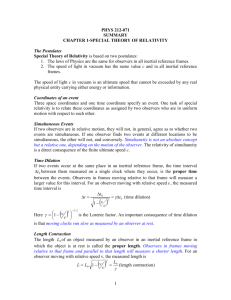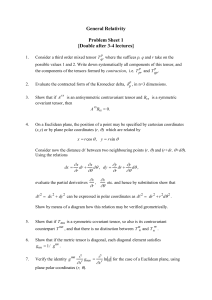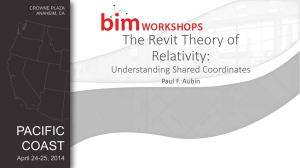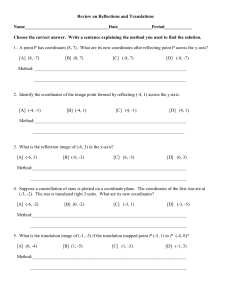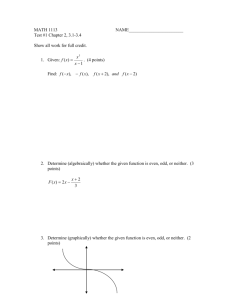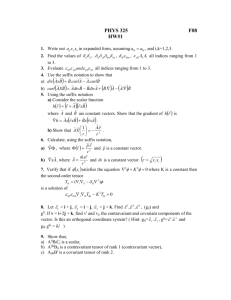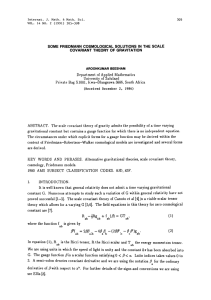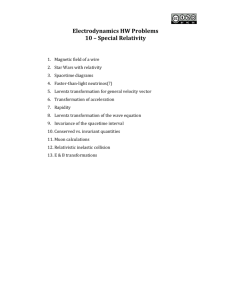7.1.1. Special Relativity
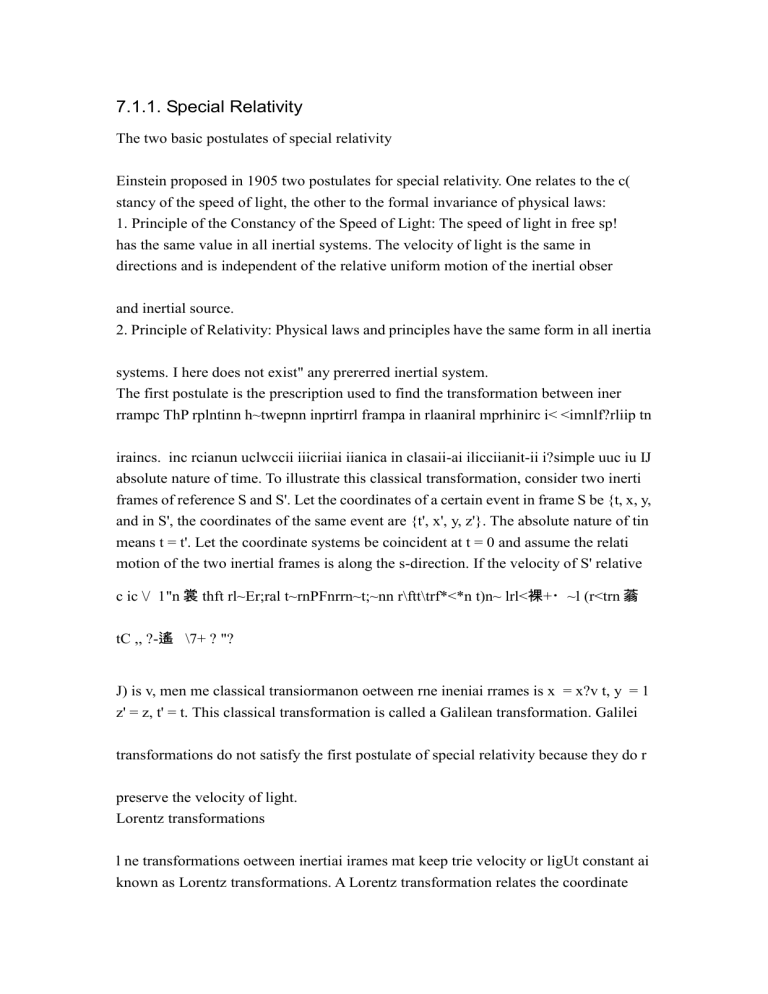
7.1.1. Special Relativity
The two basic postulates of special relativity
Einstein proposed in 1905 two postulates for special relativity. One relates to the c( stancy of the speed of light, the other to the formal invariance of physical laws:
1. Principle of the Constancy of the Speed of Light: The speed of light in free sp! has the same value in all inertial systems. The velocity of light is the same in directions and is independent of the relative uniform motion of the inertial obser and inertial source.
2. Principle of Relativity: Physical laws and principles have the same form in all inertia systems. I here does not exist" any prererred inertial system.
The first postulate is the prescription used to find the transformation between iner rrampc ThP rplntinn h~twepnn inprtirrl frampa in rlaaniral mprhinirc i< <imnlf?rliip tn iraincs. inc rcianun uclwccii iiicriiai iianica in clasaii-ai ilicciianit-ii i?simple uuc iu IJ absolute nature of time. To illustrate this classical transformation, consider two inerti frames of reference S and S'. Let the coordinates of a certain event in frame S be {t, x, y, and in S', the coordinates of the same event are {t', x', y, z'}. The absolute nature of tin means t = t'. Let the coordinate systems be coincident at t = 0 and assume the relati motion of the two inertial frames is along the s-direction. If the velocity of S' relative c ic \/ 1"n
裳
thft rl~Er;ral t~rnPFnrrn~t;~nn r\ftt\trf*<*n t)n~ lrl<
裸
+ ~l (r<trn
蓊 tC ,, ?-
遙
\7+ ? "?
J) is v, men me classical transiormanon oetween rne ineniai rrames is x = x?v t, y = 1 z' = z, t' = t. This classical transformation is called a Galilean transformation. Galilei transformations do not satisfy the first postulate of special relativity because they do r preserve the velocity of light.
Lorentz transformations l ne transformations oetween inertiai irames mat keep trie velocity or ligUt constant ai known as Lorentz transformations. A Lorentz transformation relates the coordinate
{t,x,y,z} of an event in S to the coordinates {t',x',y',z'} of the same event in anoth< inertiai system S'. To construct the Lorentz transformation, consider the infinitesim distance between two nearby points. Let {dt,dx,dy,dz} be the infinitesimal distant between two nearby points in an inertiai frame S. The space and time coordinates c a light ray between these nearby points satisfy the equation 0 = dt' - dx" - dy" - di
(We choose natural units and set the speed of light equal to one (c = 1) in this chaptel
The equation for light suggests we define a function ds" by the relation ds" = dt' - dx" dy' - dz'. We call ds" the line element. The propagation of light is described by ds" =(
Similarly in s' the line element is ds" = dt" - dx" - dy" - dz" and light is described b ds" = 0. The first postulate of relativity is satisfied if the transformation between th frames leaves the line element invariant, ds" = ds'.
The line element ds' can be written as ds' = T]ij dx'dsC1, where r) = DiagonalMatrixll
-1, -1, -1] and the coordinates dx' = {dt, dx, dy, dz} are Cartesian. We assume the Ein stein convention and sum over repeated indices. The matrix r) is the metric of th relativistic spacetime. The geometry for special relativity is pseudo-Euclidean. In S', th
I' I *,/1 ,1. ? 11 ~T-* r* I I e *l I line element is ds'- = mj dx' 'dx '. To find the transformation between the two inerti
A Lorentz transformation that relates coordinate frames at different velocities is called a boost. Consider the boost that connects an inertial frame 5 with another inertial frame
S' moving with relative speed v along the i-axis. The transformation between the two inertial frames is x' ? "f(x-vt), t' == -y(t-vx), y = y, z = z, where T = l/Ji - v'. (Recall, c == I.) The expression for a", is r 00 -v"/'
1 0 1 0 0
0 0 1 0
\-in 0 0 -/ ,
Covariant equations and tensors
The second postulate of relativity requires the equations of motion to have the same form in all inertia) coordinate systems. An equation written in a form-independent manner is said to be covariant. The construction of covariant equations leads to the study of tensors; tensors are those objects that are invariant under coordinate transformations.
The simplest of all tensors is a scalar. A scalar is trivially invariant under coordinate transformations. If/is a scalar in coordinates {x}, then in the coordinates {x'} the scalar is /', where /' = /. For example, the line element da" is a scalar, since ds'" = d$". A scalar is called a tensor of rank zero.
The next most elementary tensor is of rank one, or a vector. In four-dimensional spacetime, a vector has four components and can be either contravariant or covariant.
If the components V (i = 1,2,3,4) transform like the coordinate differentials dx', the vector is contravariant, V" -= {dx" /dx') V'. The components of contravariant vectors are denoted with superscripts. If the components of a vector, Vi (i= 0,1,2,3), transform like
V{ = (dx'/dx")Vj, the vector is covariant. We can generalize these transformations to define tensors of arbitrary rank. An arbitrary tensor can be covariant, contravariant, or mixed.
Cartesian coordinates and "flat" spacetime
It is not always convenient to use Cartesian coordinates. For example, the line element in spherical coordinates {t, r, 9, <f>} is ds" =dt"-dr"- r"d9" - r'Sin[B]2d~.
The transformation between spherical and Cartesian coordinates is well known in this case. The existence of Cartesian coordinates is a special property of pseudo-Euclidean, or
"flat, " spacetime. Only certain metrics describe flat spacetimes. For an arbitrary metric, a transformation to a Cartesian coordinate system does not generally exist, except at a point. Given a metric in an arbitrary coordinate system, the necessary and sufficient condition that there must exist a coordinate transformation to Cartesian coordinates is that the components of the curvature tensor R'jke be zero. The curvature tensor is defin mat rne components oi me curvature rensor Hjkt DC zero. i ne curvalure tensor is aem in terms of Christoffel symbols T'jk by
D' Oi Jfc OY jt i yl yl v? VI
?" ~ ate ~ a2k +r jh t" --I ie k-
The Christoffel symbols are related to the metric tensor gij by
7.1.1.a.
The two basic postulates of special relativity
7.1.1.b.
Lorentz transformations
7.1.1.c.
Covariant equations and tensors
7.1.1.d.
Cartesian coordinates and "flat" spacetime

